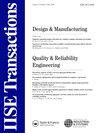影响覆盖优化问题
IF 2
3区 工程技术
Q3 ENGINEERING, INDUSTRIAL
引用次数: 0
摘要
摘要引入影响覆盖优化问题(ICOP),这是一个影响最大化问题,其中节点的激活也取决于节点在平面上的位置。具体来说,ICOP假设存在这样一个网络,其中节点变得活跃(即受影响),要么是由于它们从与活跃的内邻居的交互中获得的影响,要么是由于进入物理广告或地理围栏的覆盖区域。目标是定位固定数量的广告或地理围栏,并修改网络影响率,以最大限度地减少网络激活时间。假设马尔可夫影响模型,我们证明了ICOP是np困难的,然后我们给出了三种不同类型覆盖模式的MIP公式。非线性“大m”约束的重新公式,两种类型的有效切割,以及基于k-means算法的快速启发式算法被用来作为增强,以便通过迭代分解分支-切割(IDBC)算法求解ICOP。此外,我们提出了使用临界交点的ICOP的另一种离散公式。在具有100多个节点和1000个弧的实例中,在各种参数配置下进行了几次实验,显示了IDBC能够在几秒钟或几分钟内为大多数实例提供最佳解决方案。此外,实验表明,ICOP可以显著优于不考虑网络相互作用来做出位置决策的地理围栏覆盖模型。关键词:影响力最大化社会网络最大覆盖关键交叉点分支与切割免责声明作为对作者和研究人员的服务,我们提供此版本的已接受手稿(AM)。在最终出版版本记录(VoR)之前,将对该手稿进行编辑、排版和审查。在制作和印前,可能会发现可能影响内容的错误,所有适用于期刊的法律免责声明也与这些版本有关。本研究由美国国家科学基金会(NSF) (Award ENG/CMMI # 2145553),空军科学研究办公室(AFORS) (Award # FA9550-22-1-0236)和海军研究办公室(ONR) (Award # N00014-19-1-2329)部分资助。本文章由计算机程序翻译,如有差异,请以英文原文为准。
The Influence Coverage Optimization Problem
AbstractWe introduce the Influence Coverage Optimization Problem (ICOP), which is an influence maximization problem where the activation of nodes also depends on their location on the plane. Specifically, the ICOP assumes that there is a network where nodes become active (i.e., influenced) either by the influence they receive from interactions with active in-neighbors or by entering the coverage area of a physical ad or a Geo-fence. The objective is to locate a fixed number of ads or Geo-fences and modify the network influence rates to minimize the network activation time. Assuming a Markovian influence model, we prove that the ICOP is NP-hard, and then we present MIP formulations for three different types of coverage modes. A reformulation of the non-linear ‘big-M’ constraints, two types of valid cuts, and a fast heuristic based on the k-means algorithm are used as enhancements that facilitate solving the ICOP via an Iterative Decomposition Branch-and-Cut (IDBC) algorithm. In addition, we present an alternative discrete formulation of the ICOP using critical intersection points. Several experiments under various parameter configurations across instances with more than a hundred nodes and thousand arcs are conducted, showing the IDBC’s capability to provide optimal solutions within seconds or minutes for most instances. Moreover, the experiments reveal that the ICOP can significantly outperform a Geo-fence coverage model that does not consider network interactions to make location decisions.Keywords: Influence maximizationsocial networksmaximum coveragecritical intersection pointsbranch-and-cutDisclaimerAs a service to authors and researchers we are providing this version of an accepted manuscript (AM). Copyediting, typesetting, and review of the resulting proofs will be undertaken on this manuscript before final publication of the Version of Record (VoR). During production and pre-press, errors may be discovered which could affect the content, and all legal disclaimers that apply to the journal relate to these versions also. AcknowledgementsThis research is partially funded by the National Science Foundation (NSF) (Award ENG/CMMI # 2145553), by the Air Force Office of Scientific Research (AFORS) (Award # FA9550-22-1-0236), and the Office of Naval Research (ONR) (Award # N00014-19-1-2329).
求助全文
通过发布文献求助,成功后即可免费获取论文全文。
去求助
来源期刊

IISE Transactions
Engineering-Industrial and Manufacturing Engineering
CiteScore
5.70
自引率
7.70%
发文量
93
期刊介绍:
IISE Transactions is currently abstracted/indexed in the following services: CSA/ASCE Civil Engineering Abstracts; CSA-Computer & Information Systems Abstracts; CSA-Corrosion Abstracts; CSA-Electronics & Communications Abstracts; CSA-Engineered Materials Abstracts; CSA-Materials Research Database with METADEX; CSA-Mechanical & Transportation Engineering Abstracts; CSA-Solid State & Superconductivity Abstracts; INSPEC Information Services and Science Citation Index.
Institute of Industrial and Systems Engineers and our publisher Taylor & Francis make every effort to ensure the accuracy of all the information (the "Content") contained in our publications. However, Institute of Industrial and Systems Engineers and our publisher Taylor & Francis, our agents, and our licensors make no representations or warranties whatsoever as to the accuracy, completeness, or suitability for any purpose of the Content. Any opinions and views expressed in this publication are the opinions and views of the authors, and are not the views of or endorsed by Institute of Industrial and Systems Engineers and our publisher Taylor & Francis. The accuracy of the Content should not be relied upon and should be independently verified with primary sources of information. Institute of Industrial and Systems Engineers and our publisher Taylor & Francis shall not be liable for any losses, actions, claims, proceedings, demands, costs, expenses, damages, and other liabilities whatsoever or howsoever caused arising directly or indirectly in connection with, in relation to, or arising out of the use of the Content. Terms & Conditions of access and use can be found at http://www.tandfonline.com/page/terms-and-conditions .
 求助内容:
求助内容: 应助结果提醒方式:
应助结果提醒方式:


